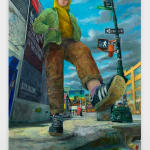
Rebecca Ness American , b. 1992
Talking to Mom, 2025
Oil on linen
228.6 x 152.4 cm. (90 x 60 in.)
Copyright The Artist
Further images
In Talking to Mom (2025), Rebecca Ness depicts herself walking through the streets of Brooklyn, speaking aloud in an imagined dialogue with her mother, who's recent death shadows her new...
In Talking to Mom (2025), Rebecca Ness depicts herself walking through the streets of Brooklyn, speaking aloud in an imagined dialogue with her mother, who's recent death shadows her new series. Around her, the city continues to pulse: adverts grin, lights shift, traffic flows. Though rooted in personal experience, the painting demonstrates her sharp eye for detail and her ability to universalise loss. Talking to Mom is both a portrait of grief and a study of how it lingers beneath the indifference of daily life.
Ness’s practice is shaped by British art, particularly Hockney’s experiments with photography and perspective. Like Hockney, she unsettles the single-point view, constructing scenes from oblique or improbable angles that draw attention to the act – and politics – of looking. In Talking to Mom, the viewer is positioned low, almost crouching, forced into a vantage point that feels cinematic. The composition recalls a film still held in suspension, charged with the quiet unease of psychological distance. As with Hockney, Ness renders the everyday uncanny. Her framing emphasises the embodied act of looking – subjective, partial, alive – rather than any encyclopaedic claim to reality.
Her self-portraits never cast her as a detached flâneur or voyeur; instead, she appears as an active participant in the creative exchange. The works suggest that she, too, is shaped by the way we, as viewers, respond. Frequently showing herself mid-act, brush in hand, Ness unravels the “myth” of the artist by presenting herself in a vulnerable, unvarnished state, visibly absorbed by her own thoughts.
Ness’s practice is shaped by British art, particularly Hockney’s experiments with photography and perspective. Like Hockney, she unsettles the single-point view, constructing scenes from oblique or improbable angles that draw attention to the act – and politics – of looking. In Talking to Mom, the viewer is positioned low, almost crouching, forced into a vantage point that feels cinematic. The composition recalls a film still held in suspension, charged with the quiet unease of psychological distance. As with Hockney, Ness renders the everyday uncanny. Her framing emphasises the embodied act of looking – subjective, partial, alive – rather than any encyclopaedic claim to reality.
Her self-portraits never cast her as a detached flâneur or voyeur; instead, she appears as an active participant in the creative exchange. The works suggest that she, too, is shaped by the way we, as viewers, respond. Frequently showing herself mid-act, brush in hand, Ness unravels the “myth” of the artist by presenting herself in a vulnerable, unvarnished state, visibly absorbed by her own thoughts.
1
of
3
